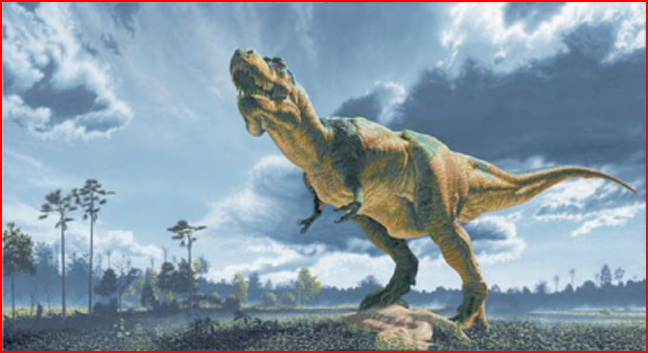
home •
about •
essential guide •
picture of the day •
thunderblogs •
news •
multimedia •
predictions •
products •
get involved •
contact
picture of the day archive subject index
Artist's conception of Tyrannosaurus rex. Credit: The Field Museum. Painting by John Gurche
Oct 10, 2007
Tyrannosaurus Rex: Prima Ballerina
A recent announcement states that the huge carnivore could outrun the fastest man, sustaining speeds of thirty kilometers an hour for short periods - while perched on six toes.Scientists at the University of Manchester have reported calculations that indicate the massive meat-eater Tyrannosaurus rex was a much faster runner than was previously thought. According to Dr. Bill Sellers, a member of the university's Life Sciences department:
“Previous research has relied on data from extant bipedal models to provide clues as to how fast dinosaurs could run. Such calculations can accurately predict the top speed of a six-tonne chicken but dinosaurs are not built like chickens and nor do they run like them. Our research involved feeding information about the skeletal and muscular structure of the dinosaurs directly into the supercomputer so it could work out how the animals were best able to move.”
For centuries, since the first taxonomic classification of a dinosaur skeleton, scientists have been debating unique aspects in their biomechanical construction and how they worked to keep the animals alive. One difficulty with dinosaur biomechanics was their tremendous weight and the effort required to move in a one-g gravity field.
The average Tyrannosaurus rex was presumed to weigh approximately 6000 kilograms. That is almost as heavy as the heaviest elephant that has ever been recorded and should provide a scale on which to judge the athletic prowess of the dinosaur. Elephants have been reported to run at speeds of thirty kilometers an hour, although “run” is not precisely accurate. Elephants tend to move at what looks like a fast walk. Since they are the only animal with four knees and hardly any toes to speak of, their biomechanics could be considered the best way to support their massive weight.
The elephant requires four legs to distribute that weight and is hesitant to step down any incline steeper than thirty degrees or lower than two feet, evidently for fear of tripping. If an elephant were to fall over and roll down a small hill, it would be crushed by its own weight and die. Indeed, some larger specimens cannot get up, unaided, if they lie down.
What does that mean for our giant, reptilian friend pictured at the top of the page? There she is, trumpeting her victory, one foot up with her chin in the air, apparently having just run down a smaller animal to eat. Could that image we all carry with us from childhood be a complete fantasy?
Twenty-eight kilometers an hour is not fast compared to the speed of a bison that can run near sixty, or a bear’s fifty kilometers an hour. Indeed, the latest theoretical understanding of dinosaurs was that they were dynamic animals, with a well-developed ability to process oxygen in huge lungs and with warm blood. For an animal that stood as tall as three men, with twelve-inch-long, knife-like teeth, weighing as much as five horses, one would think such a creature was not made to slowly shuffle after its prey.How do we break this dilemma? On the one hand, there is a carnivorous, predatory animal that is only capable of what would appear to be a slow walk for its size - some research has suggested that they could not have run even as fast as eleven kilometers an hour - versus an animal that seems to have been more suited to an active, hunting lifestyle.
In 1994, researcher Ted Holden conceived a brilliant solution to the problem by postulating the existence of a less powerful gravitational field during the time in which the dinosaurs lived. According to Holden’s theory, the lower gravity meant that the appearance and behavior of the dinosaurs – which is such a conundrum when they are placed in our current environment – becomes completely normal and not unlike the behavior of animals built for one-g acceleration.
Holden's problem was with the sauropod dinosaurs, some as big as twelve elephants, necks stretching twenty meters. His contention, after a careful scalar analysis based on muscle diameter and strength-to-weight ratios, was that the sauropods could not have supported their own weight let alone walked around, or lifted their heads off the ground. Holden referred to it in passing, but it seems as though Tyrannosaurus rex, carrying 6000 kilograms of weight on two legs and perched like a ballerina on her tiptoes, would have had the same problem. And let us not forget leaping on her prey, rolling with it to the ground, grappling it into her jaws and then getting back to her feet, without arms.
If gravity's influence is controlled through an electric dipole effect, it should be more properly defined. It is not the intention of this paper to present an analysis of electric gravity except to propose that gravitational fields can change with a changing electromagnetic field. In the Electric Universe, gravity is not the warping of space-time that Einstein taught. Instead, it is a variable with many inputs that define its overall field of influence.
As Henri Poincaré wrote in Science and Method: "What we call mass would seem to be nothing but an appearance, and all inertia to be of electromagnetic origin."By Stephen Smith
___________________________________________________________________________Please visit our Forum
The Electric Sky and The Electric Universe available now!

|
|

|
EXECUTIVE EDITORS:
David Talbott, Wallace Thornhill
MANAGING EDITORS:
Steve Smith, Mel Acheson
CONTRIBUTING EDITORS: Michael Armstrong, Dwardu Cardona,
Ev Cochrane,
C.J. Ransom, Don Scott, Rens van der Sluijs, Ian Tresman
WEBMASTER: Brian Talbott
Copyright 2007: thunderbolts.info
![]()
home •
thunderblogs •
forum •
picture of the day •
resources •
team •
updates •
contact us

